It is never silent here. It’s taken me two weeks here in the forest to realize that I am constantly immersed in a forest full of animals chittering and chattering, clicking and clucking, cheeping and chirping, hooting and howling. As a monkey person, my ears are “tuned” to react to certain sounds–monkey chirps, monkeys moving, falling fruits, for example–but that makes me wonder what I miss when I lump all other rainforest sounds into one never-ending buzz. There’s a lot of diversity and a lot of mystery in the rainforest. If my ears were “tuned,” say, to the sound of certain rare insects or birds, who knows how different my rainforest experience might be?
The area where I am currently living is referred to as a “hotspot” of biodiversity; one hectare (100 x 100 meter area) of rainforest here is reported to contain, on average, more species of trees than can be found in the entire continental North America. What does this look like on a day-to-day basis? As somebody who can name about ten species of rainforest trees, I normally see the forest as one one dense, homogeneous clutter of trees, just obstacles between me and my monkeys. But the forest is not homogeneous at all and when I finally took time to try to find two trees in view that belonged to the same species, I found that I couldn’t. Pretty remarkable.
It can be pretty tough to know where you are in the rainforest. There are trails here, but except for a few, they are very narrow and can be easily mistaken for random gaps in the rainforest. I get lost all the time. There are certain areas that I recognize better than others, but even after a few months here logging many hours in the forest, I still come across places that seem completely unfamiliar, even in the areas in which I spend most of my time. Luckily, I carry a compass and a GPS loaded with the station trail system; without them, I would never have made it back to camp on several occasions.
Strangely, I have had a remarkable run of recent peccary sightings. Peccaries are wild pig-like creatures and I have seen them, on average, about every other day for the past two weeks. Last year, in contrast, I had two peccary encounters in two months. Yesterday, I saw peccaries on three separate encounters and detected their scent an additional five times. Peccaries smell like, well, pigs but remind me of the smell of pee in the subway or in certain restrooms at Port Authority (I commuted to New York by bus all of last year). I still haven’t gotten a peccary picture, but if these sightings keep up, it’s only a matter of time.
A few nights ago, I was awake later than usual and left the lab to use the bathroom before heading to bed. When I opened the door, I saw what I thought was a mouse scurrying around the bathroom floor. Instinctively, I shut the door and decided to use the bathroom in my cabin before remembering that I was in the middle of the rainforest and that the “mouse,” even if it was just a mouse, was probably something interesting. It turned out not to be a mouse but a mouse opossum, a marsupial, and a cute one at that. I was able to snap a few photos. Figuring the little guy had nowhere to go, I shut the door again and woke a friend to show her, but when we got to the bathroom, it had vanished. Apparently, mouse opossums can climb walls.
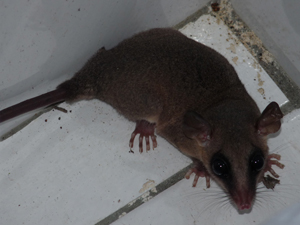
Here are a few other photos taken in the past week or so:
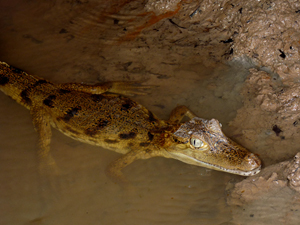
Caiman

Grasshopper

Amazon dwarf squirrel

Kingfisher
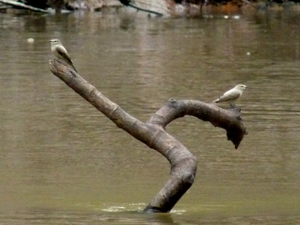
Flycatchers
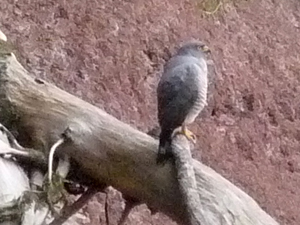
Roadside hawk
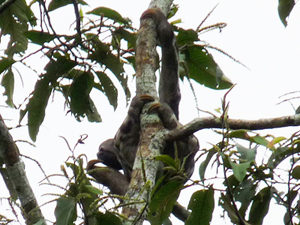
Two-toed sloth

Grossbeak

Butterfly chilling on my hand
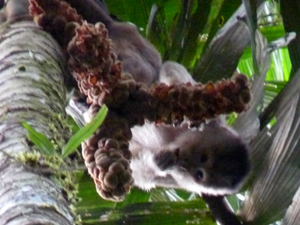
Capuchin monkey
As the only researcher here, I was tasked with giving a lecture to students about the primate project here at Tiputini, which was a little intimidating given that I graduated with a BA only three weeks ago. My lecture ran for a little over an hour and went pretty smoothly. I cannot imagine, however, how professors can string together lectures on a regular basis. After one, I’ve exhausted my supply of topics to talk about and used up all of my good jokes. The highlight of my talk was probably when I tried to pass off as genuine a photoshopped “camera trap” photo of a pink river dolphin visiting a salt lick (mineral deposits that many rainforest animals visit to supplement their diet or to mitigate the effect of certain toxic chemicals). I was able to get off a monologue about the increased predation risks that dolphins expose themselves to on land and the mineral deficiencies in their fish diets before the students called me out. I’m just glad they were paying attention.

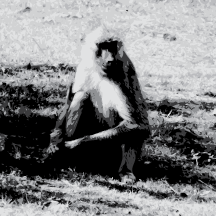
 RSS
RSS
Why are there so many different species of trees in the rain forest, and why is it so hard to find two trees of the same species? Is there evolutionary ecological reason for this?
Your pictures are awesome! How did you get the butterfly to stay on your hand?
I don’t think that your first question is an easy one to answer. The diversity of trees in the forest is part of a greater trend of higher biodiversity levels for all organisms in the tropics and that is an interesting and altogether unanswered question in evolutionary ecology. A portion of the answer is probably that the tropics contain more species richness simply because they’ve had a relatively long and undisturbed evolutionary history compared to temperate areas that have been periodically inundated by glaciers. Aside from that, however, species also appear to diversify at a higher rate in the tropics and that is a phenomenon that I don’t know a very good answer to. Interesting . . .
As for the second part of your question, the distribution of trees in a forest is principally related to available resources, competition from other trees, and the biology of any and all seed dispersers. The forest at Tiputini is a primary forest, which means that a fair proportion of trees are old and quite large. When the old trees die in a primary forest, they create gaps in the canopy that help young trees grow. In the tropics, the greater availability of water and sunlight fosters the growth of a large number of trees, leading to high tree density. In these conditions, it would be difficult for a single tree species to be versatile enough to thrive while competing with members of the same species. Furthermore, there are so many species of trees that random chance helps dictate that many different types of trees will grow in any area of the forest. While this certainly is outside of my expertise (if I may have an expertise), I think that the combination of these factors might help explain why there are so many different kinds of trees around. I also will not rule out that these areas do contain multiple individuals of the same tree species and that I simply lack the perceptiveness and/or knowledge to recognize them. I do poorly enough with the “which two are the same?” puzzles :).
As for the butterfly, it was not difficult at all keeping it on my hand. It was dancing around me for the better part of an hour and landed on me many times!